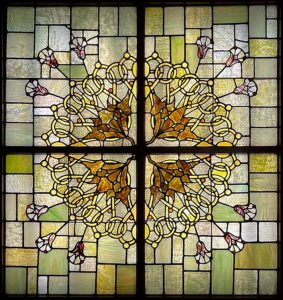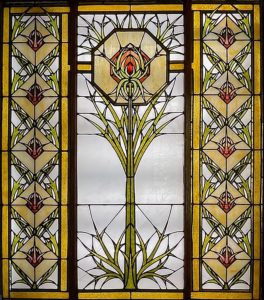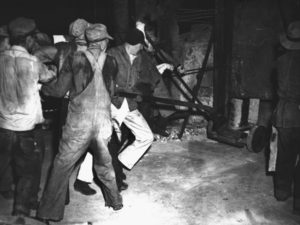
By Ron Becker, Class of 2019
In 1885 the journal Inland Architect, while enthusing about Healy and Millet’s work, stated, “after thousands of years of stained glass making, to be but a beginning.”
A visitor to their shop on Wabash Avenue described it as a, “veritable artist’s den” with examples of some of the most original examples of art glass being made.
In 1889 John La Farge exhibited a stained glass window, Angel Sealing the Servants of God, at the 1889 Exposition Universelle in Paris (The Eiffel Tower World’s Fair). That window earned La Farge a first-class medal and the Cross of the Legion of Honor. Healy & Millet submitted panels they were fabricating from Louis Sullivan’s designs for the Auditorium Building. They also won a medal, but more importantly, as docent Maurice Champagne recently wrote, Healy and Millet won the purchase prize. The French government bought their panels for exhibit. They were originally exhibited in the Musée des Arts Décoratifs and are still on display in the decorative arts section of the Musée d’Orsay.
The artisans of a so-called American Glass Movement such as John La Farge, Louis Comfort Tiffany. Healy & Millet, and several others won much acclaim for their work because they started a revolution in the creation of stained glass. The European method used flat glass in either transparent or single color that was heavily painted and fired in a kiln to fuse the colors. Three dimensional effects were achieved by the skillful application of black or brown paint to create shadows and illusions of depth. However, this somewhat impaired the passage of light.
The Americans developed several new types of glass such as opalescent, drapery, confetti ,and faceted glass. They also used glass nuggets, glass jewels, and even semi-precious stones. The glass itself was three dimensional. The most important of these was opalescent glass that could contain multiple colors in a single piece. Opalescent glass was invented by John La Farge in 1880, followed shortly by Louis Comfort Tiffany’s Favrile glass, with a milky, iridescent quality. The Americans also layered sheets of glass, called plating, creating new effects. Their projects were lightly painted, usually just flesh and facial details. They also pioneered new leading or caning techniques that allowed the use of smaller pieces of glass and the creation of more curved, organic patterns. Artists like Healy and Millet created a number of abstract patterns.




In 1886 a large natural gas field was discovered near Kokomo, Indiana. This led to the creation of a large glass industry there. In 1888 the Kokomo Opalescent Glass Company was formed. They supplied art glass to La Farge, Tiffany, Healy & Millet, and others. Their glass can be seen in architectural sites worldwide, including the Vatican, Frank Lloyd Wright’s Dana House, Disney World (Florida, California, and Tokyo), The White House, Yellowstone National Park, Washington D.C. Metro, DreamWorks Studios, and many more. It is estimated that 75% of the world’s churches contain KOG’s glass. The glass in the Chicago Cultural center is Kokomo glass. The firm is still in existence.


Chicago is fortunate to have many examples of American glass in our churches, private homes and public buildings, as well as traditional European glass to enjoy and compare.
CLICK HERE for more stories on The Bridge.




Fascinating. Thanks
Incredibly interesting! I love this story and have been fascinated with the lovely glass. Thank you for deepening my knowledge. Suzy Ruder
Thanks so much for more info on Healy and Millet. I am one of their biggest fans. When I moved to Chicago decades ago, I was always fascinated by the number of transoms on homes in Lincoln Park with stained glass and later learned that after the Chicago fire this took off as popular making us one of the leading cities to find stained glass decoration in homes as well as important buildings.
The Kokomo Glass photos are amazing!
Thanks for the great overview and for stressing the importance of KOG to Chicago
Wonderful article. Thank you